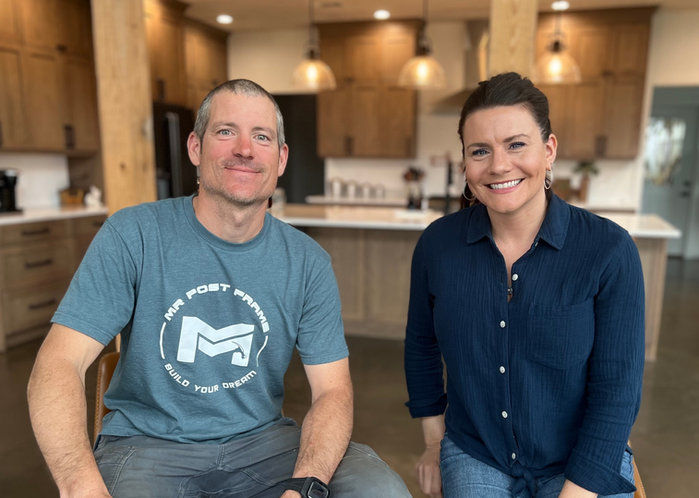We're back to update you on the progress of the Remington build. The weather remains pretty good, and we're excited to tackle the challenges ahead. Our main goal for today is to complete the installation of the steel roof on the west side of the house. These steel sheets are substantial, almost 28 feet in length, and we're gearing up for the meticulous task of placing them.

We've already taken care of the essential preliminary steps, including installing the drip edge and carefully measuring the roof. It's essential to consider every detail, such as the slightly wider peak due to the roof purlins. Our careful approach ensures that the first piece we put up is perfectly square. If all goes according to plan, we're optimistic about finishing the entire west side today.
Now, let's dive into the specifics of the West Roof. We're discussing measurements and alignments, making sure every detail is accounted for. We secure them by using screws at the top and bottom, ensuring they're aligned properly to maintain a square configuration. Precision is extremely important, especially with the initial piece. If the first piece isn't square, it sets the stage for challenges throughout the entire process.

As we work our way down, by the last rib, we have a systematic approach. Despite the presence of plywood sheathing, we prefer hitting the purlins beneath. To achieve this, we're utilizing inch and a half screws. The strategy involves measuring off the top purlin and marking at 24-inch intervals all the way down. This approach allows us to penetrate both the plywood and the purlins effectively.
Once the sheets are securely in place, our next step is to return and fasten them thoroughly. This meticulous process ensures a sturdy and well-secured metal roof, preventing any complications down the line. Negotiating the tight spaces requires a bit of finesse, but it shouldn't be a huge deal.

As we shift our focus to the Valley Detail, the complexity of dealing with different pitches becomes apparent. Our main concern here is waterproofing. To help with this, we meticulously measure, cut, and bend the valley flashing to ensure a water-tight seal. Additional layers of silicone and flashing are employed for extra protection against potential water intrusion.
The next step is to cut the steel for the A-frame structure. Our approach involves making all the necessary measurements and then using a snap line for a streamlined cutting process. Instead of cutting one piece at a time and working our way down, we aim to cut all of it in one go.
However, there's a slight complication – we have a pitch break. This means we'll be dealing with a 3/12 angle initially, and then at a certain point, it transitions to a 5/12 angle. We decided the best approach was to go up and take the measurements, and snap a line accordingly. This method allows us to efficiently cut the steel, taking into account the changing pitch without interrupting the process.

Now, let's talk about the final stages, particularly the completion of the East Roof. The peak is always a scary spot where you want to make sure everything is nice a nd s This is where things get a bit tricky. We've taken measures to mitigate any potential issues. We overlapped and flashed underneath, and then we applied flashing over the top. The ridge cap then comes over, tucking underneath, creating a seamless protective barrier. As water flows downhill, we're confident that the setup is secure and well-protected.
We then can finish up with the ridge cap installation, a crucial element to finish the roofing project. We use a vented ridge cap and sealing strips to ensure optimal ventilation while keeping water at bay. There is always the possibility of oil canning in the ridge. This is extremely hard to prevent so I wouldn’t worry about it too much. It is easy up on top of your roof, where no one can see it.
With that, we're officially done with the roof! The incorporation of an A-frame, tying back into the house, added complexity and extra time. However, if this unique design aligns with your vision, don't let the added complexity discourage you. Every architectural choice comes with its set of challenges.
Thank you,
MR Post Frame

Patreon Group:
Interested in tackling your build on your own? If you want to explore the possibility of being your GC or self-building, our Patreon membership is for you! It's a community of like-minded people offering support, discounts, Q/A, and more.